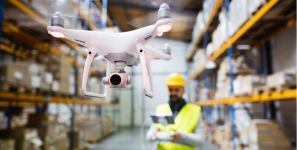IoT in Warehouse Management Market: Revolutionizing Logistics with Connected Devices
Introduction
Internet of Things (IoT) in warehouse management refers to the integration of physical warehouse operations with internet-connected devices, enabling automated and real-time data collection and analysis. This technology enhances the efficiency of warehouse operations through the seamless synchronization of equipment, inventory, and workforce management. IoT devices in warehouses typically include sensors, RFID tags, smart conveyors, autonomous robots, and wearables, which collectively contribute to streamlined processes such as inventory tracking, predictive maintenance, and optimized resource allocation.
According to Market.us, The Global IoT in Warehouse Management Market size is expected to be worth around USD 57.2 Billion By 2033, from USD 14.8 Billion in 2023, growing at a CAGR of 14.5% during the forecast period from 2024 to 2033.
The IoT in Warehouse Management Market encompasses the sale and deployment of IoT technologies specifically designed for improving warehouse operations. This market segment is driven by the need for better inventory management, increased automation, and enhanced operational efficiency in logistics and supply chain environments. It caters to various industries, including manufacturing, retail, healthcare, and automotive, where efficient, real-time warehouse operations are crucial.
Read also: “AI in Warehouse Management Market: Streamlining Logistics with Intelligent Automation”
Demand for IoT in warehouse management is surging as companies seek to bolster supply chain efficiency and reduce operational costs. This uptick in demand is primarily fueled by the growing e-commerce sector, which requires fast-paced, accurate, and flexible warehouse operations to meet consumer expectations. Additionally, the increasing adoption of omnichannel retailing strategies and the expansion of global trade are compelling businesses to invest in advanced warehouse technologies that can scale and adapt to complex logistics workflows.
Growth Factors
Several key factors are driving growth in the IoT in Warehouse Management market. Firstly, the push towards digital transformation across industries encourages the adoption of IoT to enhance data visibility and decision-making processes. Secondly, the need for efficient resource management underpins the integration of IoT solutions to optimize labor and inventory costs. Moreover, technological advancements in IoT connectivity and sensor technology have lowered implementation costs, making IoT solutions more accessible to a broader range of businesses. Lastly, regulatory pressures for safety and quality standards in warehousing are also prompting businesses to adopt IoT technologies that can ensure compliance effectively.
IoT in Warehouse Management Statistics
1. The Global IoT in Warehouse Management Market size is projected to reach approximately USD 57.2 Billion by 2033, up from USD 14.8 Billion in 2023, demonstrating a Compound Annual Growth Rate (CAGR) of 14.5% during the forecast period from 2024 to 2033.
2. In 2023, the Inventory Optimization application maintained a leading market position within the IoT in Warehouse Management Market, securing a share exceeding 21%.
3. During the same year, Large Enterprises dominated the enterprise size segment of the IoT in Warehouse Management Market, capturing more than 72% of the market share.
4. In terms of end-user industries, Manufacturing emerged as the dominant sector within the IoT in Warehouse Management Market in 2023, holding more than 24% of the market share.
5. North America led the geographical segmentation with a 43% market share, amounting to USD 6.35 Billion in revenue from the IoT in Warehouse Management Market in 2023.
Emerging Trends in IoT in Warehouse Management
1. Integration of AI and Machine Learning: Advanced robotics and AI continue to drive automation, enhancing efficiency in inventory and order management.
2. Increased Use of Autonomous Mobile Robots (AMRs) and Drones: These technologies are revolutionizing intra-warehouse material movement and inventory processes by providing flexibility and efficiency.
3. Sustainability Initiatives: There is a growing focus on implementing sustainable practices like energy-efficient systems and eco-friendly materials to reduce carbon footprints.
4. Expansion of IoT Real-time Data Usage: IoT devices provide critical real-time data that helps optimize operations, from inventory levels to equipment maintenance.
5. Adoption of Wearable Technology: Devices such as smart glasses and wristbands are increasingly used to enhance worker productivity and safety by providing hands-free operation and real-time data access.
Top Use Cases for IoT in Warehouse Management
1. Inventory Management: IoT technologies enable precise tracking and real-time visibility of inventory, reducing errors and improving fulfillment rates.
2. Predictive Maintenance: IoT sensors monitor equipment performance, predicting failures before they occur, thus minimizing downtime and maintenance costs.
3. Enhanced Worker Safety: IoT wearables and sensors improve safety by monitoring worker health and environmental conditions, alerting to potential hazards.
4. Efficient Resource Management: IoT aids in optimizing the use of resources including space, equipment, and labor, thus improving overall operational efficiency.
5. Supply Chain Visibility: IoT enhances transparency across the supply chain, enabling better coordination and faster response to supply and demand changes.
Major Challenges Facing IoT in Warehouse Management
1. Cybersecurity Risks: The increase in network-connected devices elevates the risk of data breaches and cyber attacks.
2. Integration Complexity: Merging IoT with existing systems can be challenging and requires substantial time and investment.
3. Data Management: Handling the vast amounts of data generated by IoT devices necessitates advanced data analysis capabilities and robust IT infrastructure.
4. High Initial Costs: The upfront costs for implementing IoT solutions can be prohibitive for some organizations.
5. Skill Gap: There is a growing need for skilled personnel capable of managing and maintaining IoT-based systems.
Top Opportunities in IoT in Warehouse Management
1. Customization and Personalization: IoT enables more tailored services and operations, improving customer satisfaction and operational efficiency.
2. Energy Management: IoT can significantly reduce energy consumption through smart energy management systems.
3. Automation Scalability: As businesses grow, IoT allows for the scalable expansion of automated processes to meet increased demands.
4. Enhanced Analytical Capabilities: The integration of AI with IoT paves the way for more sophisticated analytics and decision-making tools.
5. Regulatory Compliance: IoT helps ensure compliance with increasing regulatory demands across industries by automating reporting and monitoring systems.
Recent Developments
1. IBM Corporation: In December 2023, IBM announced the acquisition of StreamSets and webMethods from Software AG for €2.13 billion. This acquisition is set to enhance IBM’s capabilities in data ingestion and integration, especially within its watsonx AI platform, which is crucial for modernizing IoT applications in warehouse management.
2. HCL Technologies: In June 2024, HCL Technologies, in collaboration with IBM, announced the launch of a GenAI Center of Excellence (CoE) aimed at delivering customized AI solutions. This initiative includes training 10,000 engineers on IBM’s watsonx AI platform, which has implications for IoT-driven innovations in warehouse management.
Conclusion
The integration of IoT in warehouse management continues to revolutionize the industry, promising significant enhancements in operational efficiency, safety, and sustainability. While challenges like cybersecurity and high initial costs persist, the strategic adoption of IoT technologies represents a valuable investment for future-ready warehouses.
With advancements in AI, machine learning, and real-time data processing, warehouses can expect to see not only improved operational workflows but also a stronger alignment with long-term business goals. By leveraging these technologies, warehouses can enhance their competitive edge in an increasingly complex and demanding market landscape.
Explore More Research Reports
- AI in Retail Market: Enhancing Personalization and Efficiency in Retail
- Generative AI in Media and Entertainment: Transforming Creativity and Innovation in the Digital Era
- EdTech Market Projected to Attain USD 421 Billion by 2032, Fueled by K-12 and Higher Education Sectors
- AI in Industrial Design Market: Enhancing Design Processes with Intelligent Solutions
- Smart Warehousing Market: The Next Frontier in Logistics and Distribution





Leave a Reply